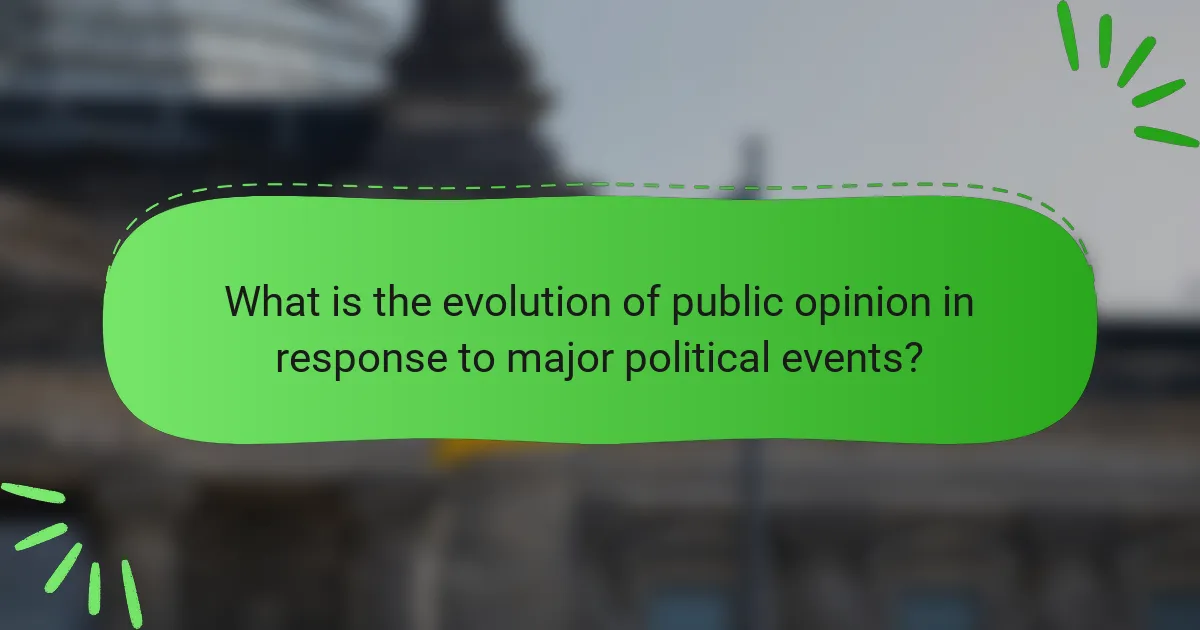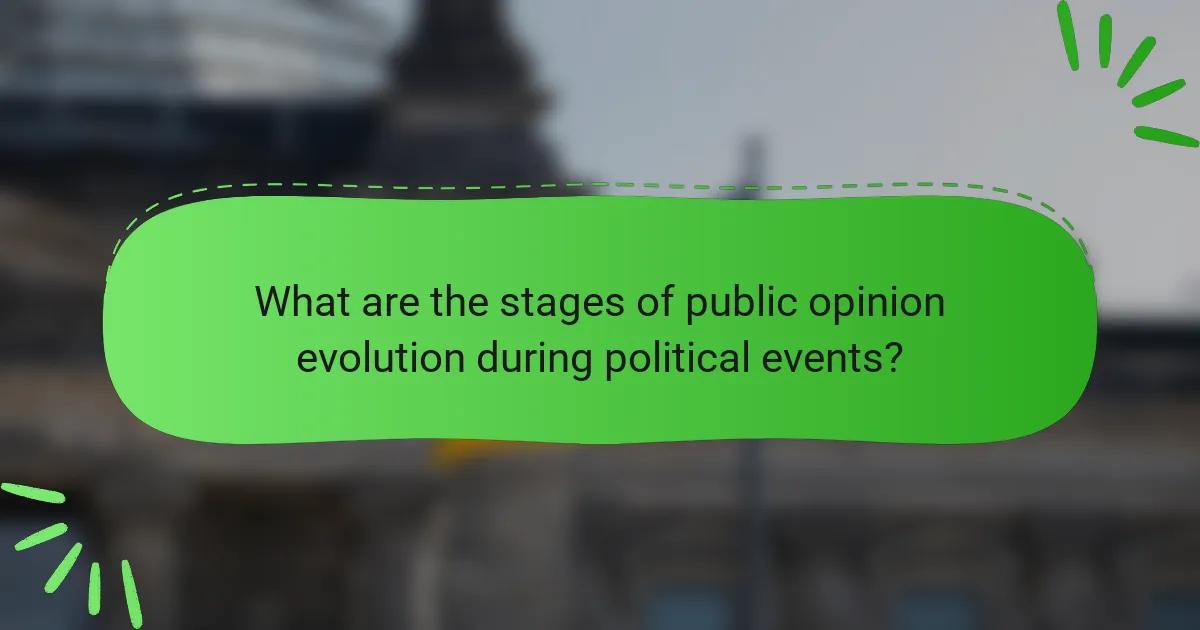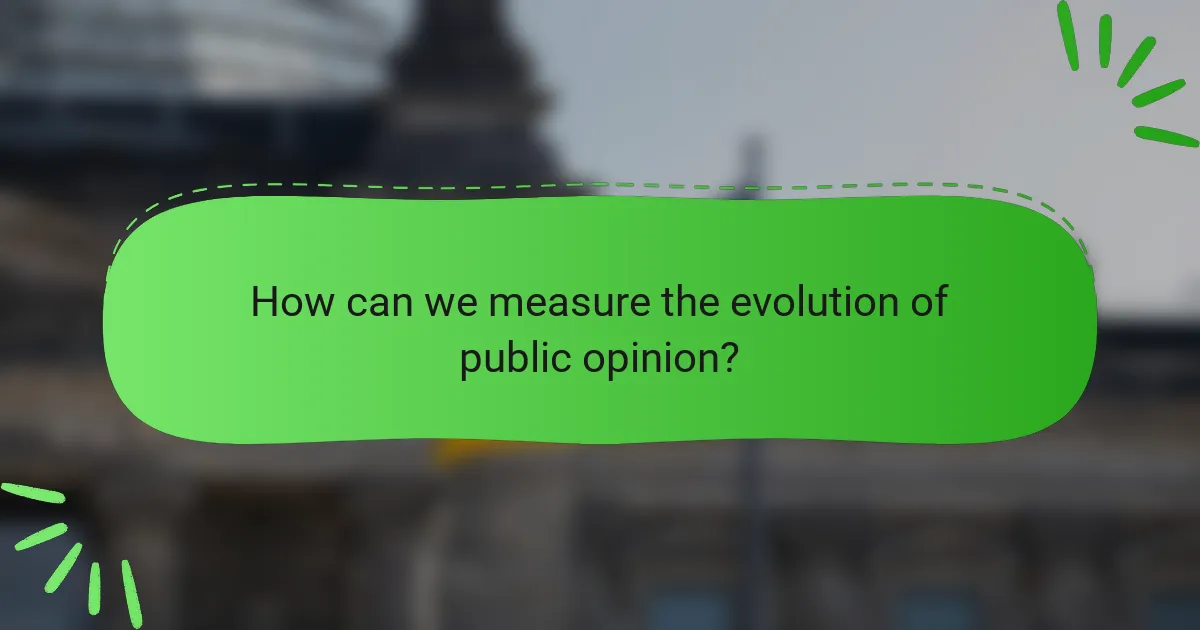Public opinion refers to the collective attitudes and beliefs of individuals regarding political events and issues. This article examines how public opinion evolves in response to major political events, highlighting the stages of awareness, interest, evaluation, and action. It discusses the immediate emotional reactions to events, such as the September 11 attacks, and how these reactions can stabilize into informed opinions over time. The influence of media coverage, social movements, and political leadership on public sentiment is also explored, along with methods for measuring public opinion through surveys, polls, and social media analysis. By analyzing these dynamics, the article provides insight into the shifting landscape of public perception in the context of significant political occurrences.

What is the evolution of public opinion in response to major political events?
Public opinion evolves in response to major political events through shifts in perception and sentiment. Initial reactions often reflect immediate emotional responses to events. Over time, these reactions can stabilize into more informed opinions. For example, the public’s response to the September 11 attacks shifted from shock to a focus on national security policies. Major political events, such as elections or scandals, can also lead to significant changes in public trust in government. Polling data often captures these shifts, revealing trends in approval ratings and public sentiment. Historical events like the Civil Rights Movement show how sustained activism can reshape public opinion over time. Public opinion is influenced by media coverage, social movements, and political leadership. Each major event contributes to a dynamic landscape of public perception and opinion.
How is public opinion defined in the context of political events?
Public opinion in the context of political events is defined as the aggregate of individual attitudes or beliefs held by the [censured] population regarding political issues, leaders, and events. It reflects the collective sentiments and perceptions of citizens. Public opinion can influence political decision-making and policy formulation. Political events, such as elections or crises, often shift public opinion significantly. For instance, surveys and polls are commonly used to measure public sentiment. Historical events, like the Watergate scandal, led to a decline in trust in government. This illustrates how public opinion evolves in response to political dynamics.
What factors contribute to shaping public opinion?
Media coverage significantly shapes public opinion. The way news is reported influences perceptions and beliefs. Social media platforms amplify voices and opinions, affecting public discourse. Personal experiences also play a critical role in shaping individual viewpoints. Public figures and influencers can sway opinions through their statements and actions. Educational background impacts how individuals interpret information and events. Cultural context provides a framework for understanding political issues. Historical events create a backdrop that influences current opinions and attitudes.
How do major political events influence public perception?
Major political events significantly influence public perception by shaping individuals’ beliefs and attitudes. These events can alter the narrative around political issues. For example, the Watergate scandal shifted public trust in government. Similarly, the September 11 attacks led to heightened national security concerns. Political events often serve as catalysts for change in public opinion. They can create a sense of urgency or fear that alters viewpoints. Polling data often reflects these shifts, as seen during election cycles. Events like protests or major legislation can also mobilize public sentiment. Overall, major political events act as pivotal moments that can redefine collective perceptions.
Why is the study of public opinion evolution important?
The study of public opinion evolution is important because it reveals how societal attitudes change over time. Understanding these shifts can provide insights into the democratic process. It helps policymakers gauge the public’s priorities and concerns. Historical events often trigger significant changes in public sentiment. For instance, the Civil Rights Movement led to a dramatic shift in attitudes towards racial equality. Analyzing public opinion trends can predict future political outcomes. Research shows that public opinion is a key factor in shaping legislation and policy decisions. Therefore, studying its evolution is crucial for effective governance and representation.
What historical examples illustrate shifts in public opinion?
The abolition of slavery in the 19th century illustrates a significant shift in public opinion. Initially, many Americans supported slavery as an economic necessity. However, as abolitionist movements gained momentum, public sentiment began to change. The publication of “Uncle Tom’s Cabin” in 1852 raised awareness about the moral implications of slavery. The Civil War further transformed views as the fight against slavery became a central issue. By the war’s end in 1865, a majority of the population supported abolition, culminating in the 13th Amendment. This historical context shows how activism and conflict can reshape societal beliefs. Another example is the women’s suffrage movement in the early 20th century. Initially, women’s voting rights faced widespread opposition. However, persistent advocacy and changing social dynamics led to increased support. The ratification of the 19th Amendment in 1920 marked a pivotal moment in public opinion, granting women the right to vote. These examples demonstrate that public opinion is not static; it evolves in response to social movements and political events.
How does public opinion impact political decision-making?
Public opinion significantly impacts political decision-making. Politicians often rely on public sentiment to guide their policies. When public opinion shifts, elected officials may change their stances to align with constituents. Surveys and polls are commonly used to gauge public sentiment. For example, the approval ratings of presidents can influence their legislative agendas. Historical events, such as the Vietnam War protests, led to changes in government policies. Additionally, public opinion can affect election outcomes, as candidates tailor their messages to resonate with voters. In summary, public opinion serves as a crucial barometer for political decision-making.

What are the stages of public opinion evolution during political events?
The stages of public opinion evolution during political events typically include awareness, interest, evaluation, and action. Initially, awareness occurs when individuals become informed about the political event. This stage often involves media coverage and discussions in social circles. Following awareness, interest develops as people begin to engage more deeply with the topic. They seek out information and opinions from various sources.
Next, evaluation happens as individuals form their opinions based on the information gathered. This stage is influenced by personal beliefs, values, and the opinions of trusted figures. Finally, action takes place when individuals express their opinions through activities such as voting, protests, or discussions. Each stage reflects a progression in how public opinion forms and shifts in response to political events.
How does public opinion initially respond to major political events?
Public opinion initially responds to major political events through immediate reactions and shifts in sentiment. These reactions often manifest as heightened emotional responses, such as outrage or support. Surveys and polls frequently capture these initial sentiments shortly after the event. For example, following significant events like elections or crises, public approval ratings can fluctuate dramatically. Research shows that within days of such events, opinion polls can reflect a change of several percentage points. This rapid response is driven by media coverage and social media discussions. The framing of the event by news outlets also influences public perception. Historical data indicates that the initial public opinion can set the tone for longer-term attitudes.
What role does media play in shaping initial reactions?
Media plays a crucial role in shaping initial reactions to major political events. It serves as the primary source of information for the public. Through various formats, such as news articles, broadcasts, and social media, media outlets disseminate information rapidly. This information influences how people perceive events and form opinions. Studies show that the framing of news stories can significantly affect public perception. For example, a study by Iyengar and Kinder (1987) found that the way issues are presented can alter audience priorities. Additionally, media can amplify specific narratives, leading to heightened emotional responses. This amplification can create a sense of urgency or fear, impacting public behavior and opinion. Overall, media acts as a powerful intermediary in the communication process during political events.
How do social movements affect early public sentiment?
Social movements significantly influence early public sentiment by mobilizing individuals around shared causes. They create awareness and urgency regarding social issues. For example, the Civil Rights Movement in the 1960s shifted public opinion toward greater support for racial equality. This was evidenced by increased media coverage and public demonstrations. Research indicates that social movements can lead to changes in public attitudes within a short time frame. A study by Della Porta and Diani highlights how collective action frames issues in ways that resonate with broader audiences. As a result, social movements often catalyze shifts in societal norms and values.
What are the long-term effects of political events on public opinion?
Political events have significant long-term effects on public opinion. They can shape societal values and perceptions for years. For instance, major events like elections, protests, or policy changes can create lasting shifts in how communities view governance. A study by Pew Research Center in 2020 found that significant political events often lead to increased polarization among the public. This polarization can manifest in divergent opinions on key issues, such as healthcare and immigration. Additionally, political events can influence voter turnout and engagement levels in subsequent elections. Historical examples include the impact of the Watergate scandal, which led to a decline in public trust in government institutions. Over time, these shifts can alter the political landscape and influence future policy decisions.
How does sustained media coverage alter public perception over time?
Sustained media coverage significantly alters public perception over time by shaping narratives and influencing attitudes. Continuous reporting reinforces specific viewpoints, making them more salient in public consciousness. For example, the media’s extensive coverage of climate change has increased public awareness and concern over the years. According to a study by the Pew Research Center, consistent media attention on social issues correlates with heightened public engagement and shifts in opinion. Furthermore, repeated exposure to particular themes or stories can lead to normalization of certain ideas, changing the overall perception within society. This process is evident in how public attitudes towards same-[censured] marriage evolved as it received more media focus.
What are the implications of changing public opinion for future political events?
Changing public opinion significantly influences future political events. It can shift voter behavior and alter election outcomes. For instance, a change in public sentiment regarding healthcare can lead to new policies or reforms. Historical examples, such as the 2008 U.S. presidential election, show how public opinion on economic issues swayed voters. Additionally, changing opinions can impact party strategies and candidate platforms. Politicians often adjust their messages to align with public sentiment. This responsiveness can enhance electoral success or lead to political instability. Overall, evolving public opinion shapes the political landscape and drives legislative agendas.

How can we measure the evolution of public opinion?
Public opinion can be measured through surveys and polls. These tools gather data from a representative sample of the population. They assess attitudes, beliefs, and preferences on various issues. Tracking changes over time reveals how public opinion evolves. For example, Gallup and Pew Research Center conduct regular polls. Their findings show shifts in public sentiment during political events. Analyzing social media sentiment also provides insights into public opinion. Platforms like Twitter and Facebook reveal real-time reactions to events. Content analysis of news articles can further highlight public discourse. Combining these methods offers a comprehensive view of public opinion’s evolution.
What tools and methods are used to assess public opinion changes?
Surveys and polls are primary tools used to assess public opinion changes. These methods gather quantitative data from a sample of the population. Surveys often utilize structured questionnaires to measure attitudes and perceptions. Polls can be conducted through various mediums, including telephone, online, or face-to-face interviews. Focus groups serve as qualitative methods to explore deeper insights into public sentiment. They involve guided discussions among a small group of participants. Social media analysis is increasingly used to gauge public opinion in real-time. This method examines trends in online conversations and engagements. Historical data comparisons provide context to current public opinions by analyzing past survey results. Each of these tools and methods offers unique insights into how public opinion evolves over time.
How do polls and surveys capture shifts in public sentiment?
Polls and surveys capture shifts in public sentiment by systematically gathering data on people’s opinions. They use structured questionnaires to assess attitudes on various issues. The data collected reflects the prevailing views at a specific time. Polling organizations analyze responses to identify trends and changes over time. For example, a Gallup poll can show how support for a political figure fluctuates after significant events. This method provides quantifiable insights into public opinion dynamics. Historical examples demonstrate that surveys effectively track sentiment changes during elections or crises.
What are the limitations of traditional methods in measuring public opinion?
Traditional methods in measuring public opinion have significant limitations. These methods often rely on surveys and polls, which can introduce bias. Sample sizes may not represent the broader population accurately. Timing of surveys can also affect results, especially during major political events. Respondents may provide socially desirable answers rather than their true opinions. Additionally, traditional methods can struggle to capture the nuances of public sentiment. They often overlook demographic variations in opinion. These factors can lead to misleading conclusions about public sentiment.
How do different demographics influence public opinion evolution?
Different demographics significantly influence the evolution of public opinion. Age, gender, ethnicity, and education level impact perspectives on political issues. For example, younger voters often prioritize climate change, while older voters may focus on social security. Gender differences can lead to varying opinions on reproductive rights and healthcare access. Ethnic backgrounds shape views on immigration and social justice. Education level correlates with political engagement and awareness. Studies show that demographic shifts can lead to substantial changes in voting patterns and policy preferences. In the 2020 U.S. election, for instance, demographic groups such as Black and Hispanic voters showed increased support for progressive candidates, reflecting evolving public opinion on equity and justice.
What role does age play in shaping political views?
Age significantly influences political views. Younger individuals often prioritize social issues and progressive policies. In contrast, older individuals may lean towards traditional values and conservative perspectives. Research indicates that political socialization occurs during formative years. This process shapes long-term political affiliations. For example, a Pew Research Center study found that millennials are more likely to support climate action compared to older generations. Additionally, older voters tend to have different perceptions of government effectiveness. Age-related experiences, such as economic conditions during one’s youth, also impact political beliefs. Overall, age plays a crucial role in defining political perspectives and preferences.
How do socioeconomic factors affect public opinion during political events?
Socioeconomic factors significantly influence public opinion during political events. Individuals’ economic status, education level, and social class shape their perspectives. For instance, people with higher income levels often prioritize different issues than those with lower incomes. Education affects critical thinking and media consumption, leading to varied interpretations of political messages. Additionally, social class impacts access to information and networks that can sway opinions. Research indicates that during elections, lower-income voters may focus more on economic stability, while affluent voters might prioritize tax policies. This divergence can lead to polarized opinions on political issues and candidates.
What strategies can be employed to engage with evolving public opinion?
To engage with evolving public opinion, organizations can employ several strategies. First, they should actively monitor social media and news outlets for real-time feedback. This helps in understanding public sentiment as it changes. Second, they can utilize surveys and polls to gather quantitative data on public opinions. This data can provide insights into trends and shifts in perspective. Third, engaging in open dialogues through town hall meetings or online forums allows for direct interaction with the public. This fosters a sense of community and involvement. Fourth, tailoring communication strategies to address specific concerns raised by the public can enhance relatability and trust. Finally, adapting messaging based on feedback ensures relevance and responsiveness to public needs. These strategies are supported by research indicating that organizations that actively engage with public opinion tend to build stronger relationships with their audiences.
How can political leaders effectively respond to shifts in public sentiment?
Political leaders can effectively respond to shifts in public sentiment by actively listening to constituents. They should engage in regular communication through town halls and social media. This allows leaders to gauge public opinion accurately. Additionally, leaders must be adaptable in their policies. They should align their agendas with the changing needs of the public. Data from surveys and polls can guide these adjustments. Historical examples, such as President Franklin D. Roosevelt’s New Deal, demonstrate effective responses to public sentiment. His policies were shaped by the Great Depression’s impact on citizens. Thus, understanding and responding to public sentiment is crucial for political leaders.
What best practices exist for communicating during political events?
Clear and transparent communication is essential during political events. Establishing a consistent message helps avoid confusion. Engaging with the audience through active listening fosters trust. Utilizing multiple channels, such as social media and traditional media, increases reach. Training spokespersons ensures they convey messages effectively. Monitoring public reactions allows for timely adjustments to communication strategies. Historical examples, like the Obama campaign’s use of social media, demonstrate the effectiveness of these practices.
The main entity of this article is the evolution of public opinion in response to major political events. The article explores how public sentiment shifts following significant political occurrences, detailing the stages of public opinion evolution, including awareness, interest, evaluation, and action. It examines the factors that shape public opinion, such as media coverage, social movements, and demographic influences, while highlighting historical examples that illustrate these changes. Furthermore, the article discusses the implications of evolving public opinion for political decision-making and future events, emphasizing the importance of understanding these dynamics for effective governance and representation.